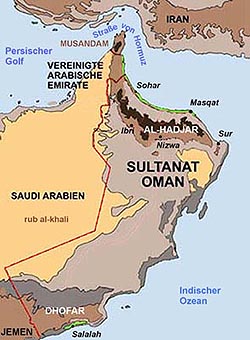The Landscapes of Oman
The landscapes of the Sultanate of Oman are very varied: the fjords of the Musandam peninsula, the spectacular Hajar mountains, the vast dunes of the Rub al-Khali and Wahiba deserts, lush green Dhofar, the fertile Batinah coast and the modern capital Muscat.

Arriving at the airport in Seeb, you land on the divide between two geographically completely different worlds, the Batinah Plain and the Hajar Mountains. The Batinah Plain stretches 270 kilometres along the coast northwest of Seeb to the border with the United Arab Emirates. It is a fertile strip which is farmed the whole year round.
The plain is surrounded by the great rocky Hajar Mountains (hajar is Arabic for "rocky"), which run parallel to the coast and form an insurmountable wall to the interior. The mountain chain stretches in a wide, 650 kilometre long curve from Ras al Hadd, the most easterly point of Oman, to the most northerly, the tip of the Musandam peninsula, at the entrance to the Persian Gulf. Its wildly-fissured fjord-like landscape has led to its being called the "Norway of the Middle East". These rugged fold-mountains rise to a height of 3,075 metres in the massif of Jabal al Akhdar, the "Green Mountain". The Sumail Gap splits the mighty mountain chain in two: the Western Hajars (or Al Hajar al Gharbi) and the Eastern Hajars (or Al Hajar ash Sharqi).
An endless, rock-strewn plateau runs 500 kilometres south from the foothills of the mountains. This is the Jiddat al Harasis, once more home to the great white Oryx. To the west of this hostile region is the even more inhospitable, seemingly unending central Arabian desert, the Rub al Khali, or Empty Quarter, with its high dunes.
South of Sharqiyah, the Wahiba Sands stretch 200 kilometres by 80 kilometres wide along the coast. With its rolling sand dunes, this is the archetypal desert formation.
The most southerly province is Dhofar, which, with its 100,000 square kilometres, makes up a third of the country. Between June and September the south coast is washed by the monsoon rains (or khareef), giving a tropical fecundity to the 8 kilometre wide band of coastal plain near Salalah, the second largest city of Oman. During these months the whole region is enveloped in heavy fog and drizzle. Whilst the rest of the Arabian peninsula is wilting under the most extreme heat, here temperatures rarely exceed 35°C. This mountain range is the historical source of frankincense.
Georg Popp
What makes this travel guide so special? This book is a product of the long-term personal friendship between the authors, Mr Georg Popp and Mr Juma Al-Maskari and their continuing fascination with the Sultanate of Oman. Combining their insights from European and Omani perspectives, they have produced a guide which is as much about culture and history as it is a practical guide for planning your itinerary.





